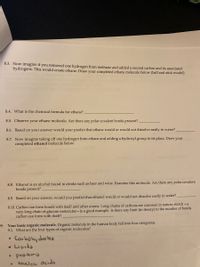
Chemistry
10th Edition
ISBN: 9781305957404
Author: Steven S. Zumdahl, Susan A. Zumdahl, Donald J. DeCoste
Publisher: Cengage Learning
expand_more
expand_more
format_list_bulleted
Concept explainers
Question

Transcribed Image Text:8.3. Now imagine if you removed one hydrogen from methane and added a second carbon and its associated
hydrogens. This would create ethane. Draw your completed ethane molecule below (ball and stick model).
8.4. What is the chemical formula for ethane?
8.5. Observe your ethane molecule. Are there any polar covalent bonds present? .
8.6. Based on your answer would your predict that ethane would or would not dissolve easily in water?
8.7. Now imagine taking off one hydrogen from ethane and adding a hydroxyl group in its place. Draw your
completed ethanol molecule below,
8.8. Ethanol is an alcohol found in drinks such as beer and wine. Examine this molecule. Are there any polar covalent
bonds present?
8.9. Based on your answer, would you predict that ethanol would or would not dissolve easily in water?
8.10. Carbon can form bonds with itself and other atoms. Long chains of carbons are common in nature; starch -a
very long chain of glucose molecules- is a good example. Is there any limit (in theory) to the number of bonds
carbon can form with itself?
9. Your basic organic molecule. Organic molecule in the human body fall into four categories.
9.1. What are the four types of organic molecules?
Carbohy drotes
Lipids
• prodeins
Nuclec Acids
Expert Solution
This question has been solved!
Explore an expertly crafted, step-by-step solution for a thorough understanding of key concepts.
This is a popular solution
Trending nowThis is a popular solution!
Step by stepSolved in 3 steps with 3 images

Knowledge Booster
Learn more about
Need a deep-dive on the concept behind this application? Look no further. Learn more about this topic, chemistry and related others by exploring similar questions and additional content below.Similar questions
- a) What is the total number of valence electrons for ammonia, NH3? b) On your scratch paper draw the Lewis Structure for NH3 and make sure to show all the bonds and lone pairs. c) What is the geometry around the nitrogen atom? d) Is this molecule polar, or non-polar? Explain your choice. The answers for b) and c) must match for credit! You must turn in your scratch paper!arrow_forwardQUESTION 4 Draw the lewis dot structures below. Which of the compounds below has 1 lone-pairs and 3 bonding pairs of electrons in the molecule? F2 H20 NH3 SO2 Click Save and Submit to save and submit. Click Save All Answersko save all ansuwers. Save Al another NDC member organization regardless of any circumstances étv W 17 MacBook Pro * # 2$ & 3 4 6 7 8 9arrow_forwardA Lewis structure for ozone (O₃) is shown on the left below. Draw another equivalent resonance structure of O₃.arrow_forward
- Given that phosphorus obeys the octet rule. Draw the Lewis structure for the PH4+ ion before answering the following questions (You do NOT submit a picture just answer the questions. WARNING: Do NOT USE the internet or other sources to find the structures. Use ONLY the rules taught in class. Answer the following questions for the Lewis structure for the PH4+ ion given that phosphorous obeys the octet rule. Give answers as numbers (1,2,3 ...etc.) not words (one, two three etc.) How many bonds does the phosphorus atom form How many electrons surround the phosphorous atom How many lone pairs are around the phosphorous atom How many bonds does each hydrogen atom form How many lone pairs are around each hydrogen atom How many electrons surround each hydrogen atomarrow_forwardClasslink Formulas & Naming Compounds | X i testing.illuminateed.com/assessment/6050bf900e2b2ec7078b54b7/6051ecd60afa0911088b45a5/1?rldbqn=1 Formulas & Naming Compounds QUEST 1) When naming compounds, which type must have a prefix in the name? a. Ionic b. Covalent c. Polar covalent d. Acidic e. B&C 2) How can you tell a compound is an acid by looking at its formula? a. It has oxygen in it. TL O Type here to search DELL F2 F3 F4 F5 F6 F7 F8 F9 to Home F10 F11 PrtScr F12 %23 %24 & LESarrow_forward
arrow_back_ios
arrow_forward_ios
Recommended textbooks for you
 ChemistryChemistryISBN:9781305957404Author:Steven S. Zumdahl, Susan A. Zumdahl, Donald J. DeCostePublisher:Cengage Learning
ChemistryChemistryISBN:9781305957404Author:Steven S. Zumdahl, Susan A. Zumdahl, Donald J. DeCostePublisher:Cengage Learning ChemistryChemistryISBN:9781259911156Author:Raymond Chang Dr., Jason Overby ProfessorPublisher:McGraw-Hill Education
ChemistryChemistryISBN:9781259911156Author:Raymond Chang Dr., Jason Overby ProfessorPublisher:McGraw-Hill Education Principles of Instrumental AnalysisChemistryISBN:9781305577213Author:Douglas A. Skoog, F. James Holler, Stanley R. CrouchPublisher:Cengage Learning
Principles of Instrumental AnalysisChemistryISBN:9781305577213Author:Douglas A. Skoog, F. James Holler, Stanley R. CrouchPublisher:Cengage Learning Organic ChemistryChemistryISBN:9780078021558Author:Janice Gorzynski Smith Dr.Publisher:McGraw-Hill Education
Organic ChemistryChemistryISBN:9780078021558Author:Janice Gorzynski Smith Dr.Publisher:McGraw-Hill Education Chemistry: Principles and ReactionsChemistryISBN:9781305079373Author:William L. Masterton, Cecile N. HurleyPublisher:Cengage Learning
Chemistry: Principles and ReactionsChemistryISBN:9781305079373Author:William L. Masterton, Cecile N. HurleyPublisher:Cengage Learning Elementary Principles of Chemical Processes, Bind...ChemistryISBN:9781118431221Author:Richard M. Felder, Ronald W. Rousseau, Lisa G. BullardPublisher:WILEY
Elementary Principles of Chemical Processes, Bind...ChemistryISBN:9781118431221Author:Richard M. Felder, Ronald W. Rousseau, Lisa G. BullardPublisher:WILEY

Chemistry
Chemistry
ISBN:9781305957404
Author:Steven S. Zumdahl, Susan A. Zumdahl, Donald J. DeCoste
Publisher:Cengage Learning

Chemistry
Chemistry
ISBN:9781259911156
Author:Raymond Chang Dr., Jason Overby Professor
Publisher:McGraw-Hill Education

Principles of Instrumental Analysis
Chemistry
ISBN:9781305577213
Author:Douglas A. Skoog, F. James Holler, Stanley R. Crouch
Publisher:Cengage Learning

Organic Chemistry
Chemistry
ISBN:9780078021558
Author:Janice Gorzynski Smith Dr.
Publisher:McGraw-Hill Education

Chemistry: Principles and Reactions
Chemistry
ISBN:9781305079373
Author:William L. Masterton, Cecile N. Hurley
Publisher:Cengage Learning

Elementary Principles of Chemical Processes, Bind...
Chemistry
ISBN:9781118431221
Author:Richard M. Felder, Ronald W. Rousseau, Lisa G. Bullard
Publisher:WILEY